6 Agile Procurement Case Studies to Know About


Agile procurement promises to transform how organizations operate, bringing numerous benefits to those willing to embrace it.
But instead of just theorizing about these advantages, why not explore real-life examples that show how agile procurement works in action?
That’s precisely what we will do today.
We will take you on a journey through the experiences of six companies that have integrated agility into their procurement processes.
These stories vividly demonstrate the practical benefits and results that agile procurement achieves and, as such, can serve you as an inspiration.
First up? The intriguing case study of Air France.
Air France KLM Martinair Cargo, a significant player in the air cargo industry and a specialist within the Air France KLM Group, faced a formidable challenge.
They needed to modernize their door-to-door cargo operations within a tight six-month timeframe, requiring the development of a new booking system to streamline processes and enhance efficiency.
However, assembling a remote team for this task was no easy feat.
Traditionally, such endeavors involved cumbersome procurement procedures and lengthy team-building processes, often resulting in delayed project starts.
Recognizing the urgency and importance of innovation, Air France opted for a different approach: Lean Agile Procurement (LAP).
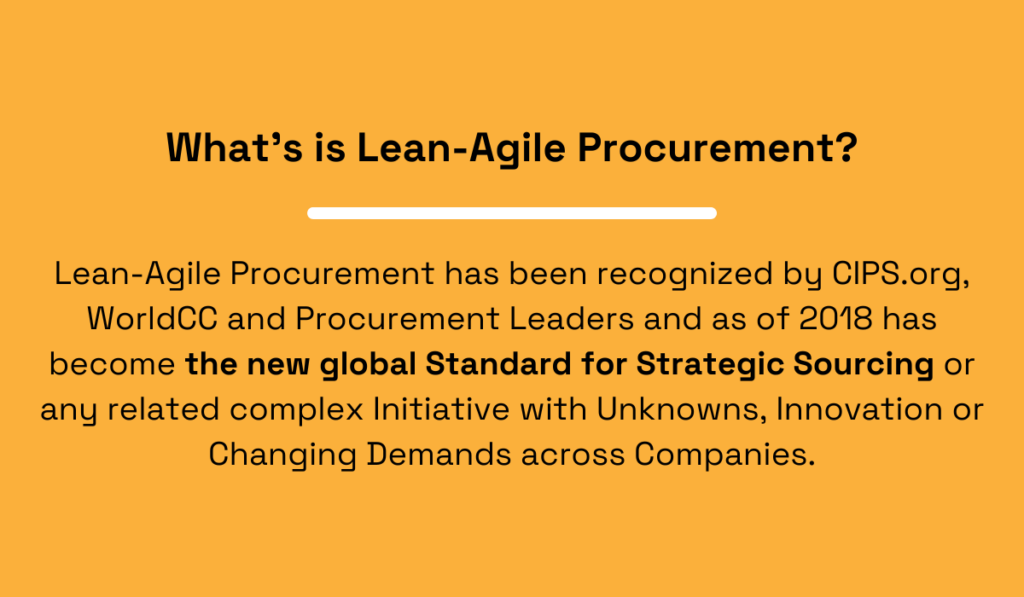
Illustration: Veridion / Quote: LAP Alliance
LAP operates through several key steps, including assembling a cross-functional team, aligning stakeholders, and establishing a shared vision to facilitate adaptive and collaborative procurement.
A critical part of LAP is preparing to meet shortlisted vendors, which is followed by the Big Room Workshop.
This is where the team, stakeholders, and vendors collaborate to create proposals and contracts and make collective decisions.
At its core, Lean Agile Procurement emphasizes close collaboration between cross-functional teams, stakeholders, customers, and suppliers, enabling faster decision-making based on input from all parties involved.
Below, you can see the results of such an approach to procurement:

Source: LAP Alliance
Returning to the case study, Air France aimed to find a vendor capable of quickly understanding the complexities of the cargo industry and delivering swift results.
Their departure from traditional methods involved streamlining the vendor selection process and promoting collaboration through hands-on workshops.
Their approach followed LAP steps, including:
The two-day workshop allowed for close collaboration with suppliers, enabling Air France to assess cultural fit, discuss challenges and risks, and co-create proposals.
And the results of this collaborative approach were impressive.
Within just six weeks, Air France had selected a vendor and kicked off the project, setting the stage for a series of timely milestones.
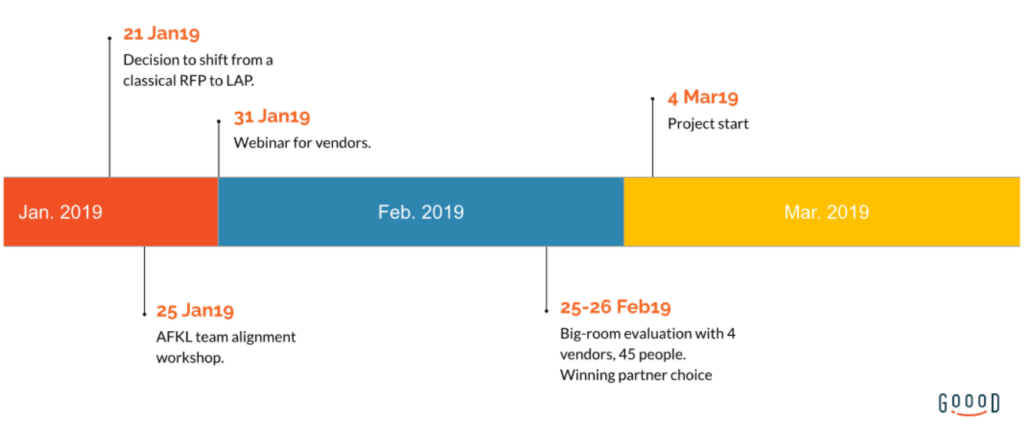
Source: Agile Business Consortium
Frédéric Jacques, Cargo Operations Development Manager at Air France, praised the LAP approach for its effectiveness, highlighting its stark contrast with traditional procurement practices:
“We usually end up with offers consisting of 50 to 80 page documents. We tend to choose the best writers. Instead, within two days, we were able to get a true feel of actually working with these companies.”
Overall, by adopting Lean Agile Procurement, Air France overcame traditional procurement hurdles and set a new benchmark for excellence in the industry.
Zalando, the German online fashion giant, is a prime example of agile procurement in action.
Born in the new economy era, Zalando operates with inherent agility, as described by Alejandro Basterrechea, Director of Indirect Procurement.
Naturally, this means they apply agility in procurement, as well as in other operations.
One prime example of Zalando’s agile procurement approach is how they implemented their procure-to-pay process.
To do so, they used the following agile methods:
By adopting these agile practices, Zalando has significantly shortened cycle times from design to go-live, which increased customer satisfaction.
Additionally, they significantly reduced maverick spend while also boosting e-invoicing to over 50% within 6 months.
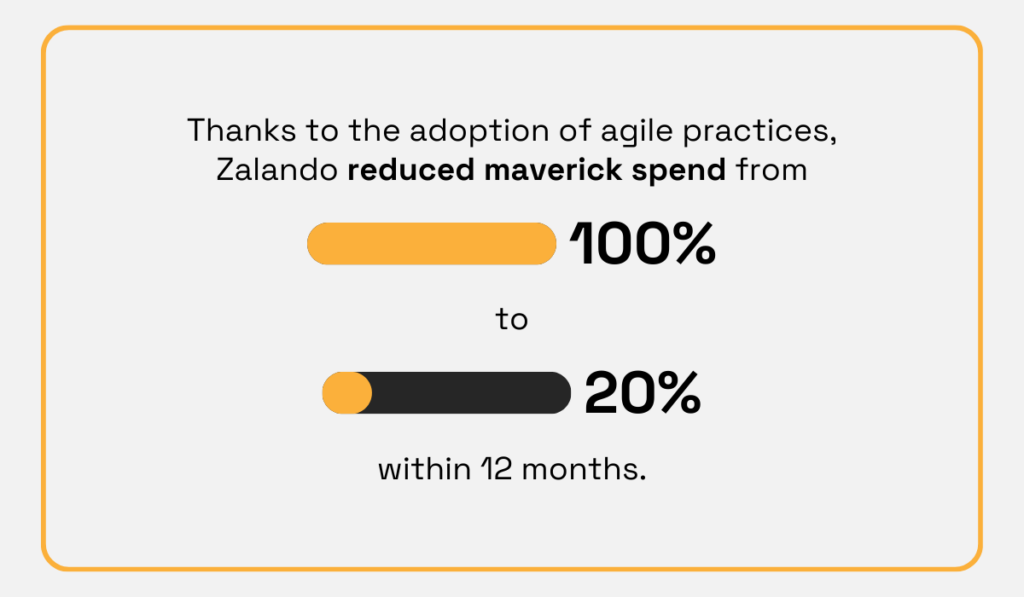
Illustration: Veridion / Data: LAP Alliance
This achievement is crucial because it signifies better control and compliance within the procurement process.
By reducing maverick spend, Zalando can ensure that purchases are made in accordance with established contracts and agreements, leading to cost savings and improved supplier relationships.
Moreover, automating invoicing streamlines the invoicing process, reduces manual errors, and minimizes processing times and costs.
All while also enhancing transparency and efficiency in financial operations.
Overall, these improvements contribute to Zalando’s bottom line and reinforce its commitment to effective procurement practices.
Furthermore, Zalando’s procurement team applies Scrum methodology in their commercial organization.
For instance, they organize swarm teams of buyers for negotiations, where each team focuses on one or a few specific negotiations in a short time.
This agile approach has notably reduced the tender-to-contract process from 4 months to 2 or 3 weeks, and achieved savings of 15%, surpassing the expected 9%.
However, this approach does require you to have pre-qualified suppliers and comparable products.
Zalando’s commitment to agility is ingrained in its culture, fostering an agile mindset throughout the organization.
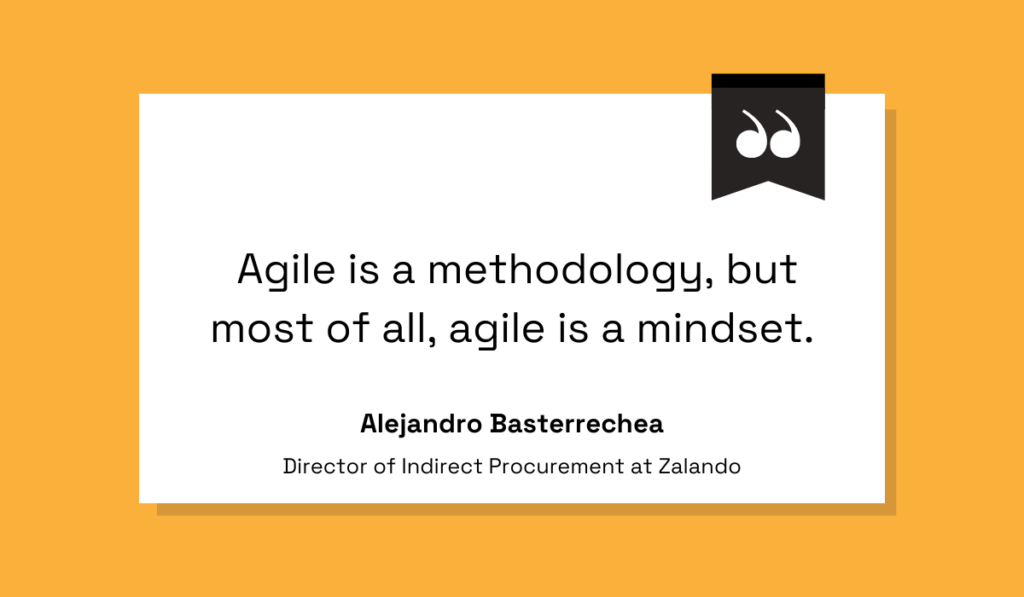
Illustration: Veridion / Quote: LAP Alliance
So, it’s no surprise that Zalando continues to experience growing success due to its dedication to flexible, adaptable, and customer-centric practices, not only in procurement but also across all aspects of its operations.
The next case study on our list explains how the Centers for Medicare & Medicaid Services (CMS) is implementing agile procurement in their Medicare Payment Systems Modernization (MPSM) project.
CMS, the world’s largest medical insurer, faced challenges with outdated payment systems and failed modernization attempts using traditional waterfall approaches.
To address these challenges, CMS adopted an agile approach to modernize its payment system.
They decided to focus on smaller, less risky initiatives that deliver business value in months instead of years.
So, the project scope was divided into two parts:
This allowed them to focus on immediate priorities while keeping an eye on the bigger picture.
CMS began by transitioning to a cloud-based infrastructure to reduce costs, enable faster and modular changes, and provide real-time analytics.
Recognizing that the modernization effort would span several years, CMS needed a flexible contract to support both short-term and long-term goals.
After comparing various options, they selected a blanket purchase agreement (BPA) because it would:
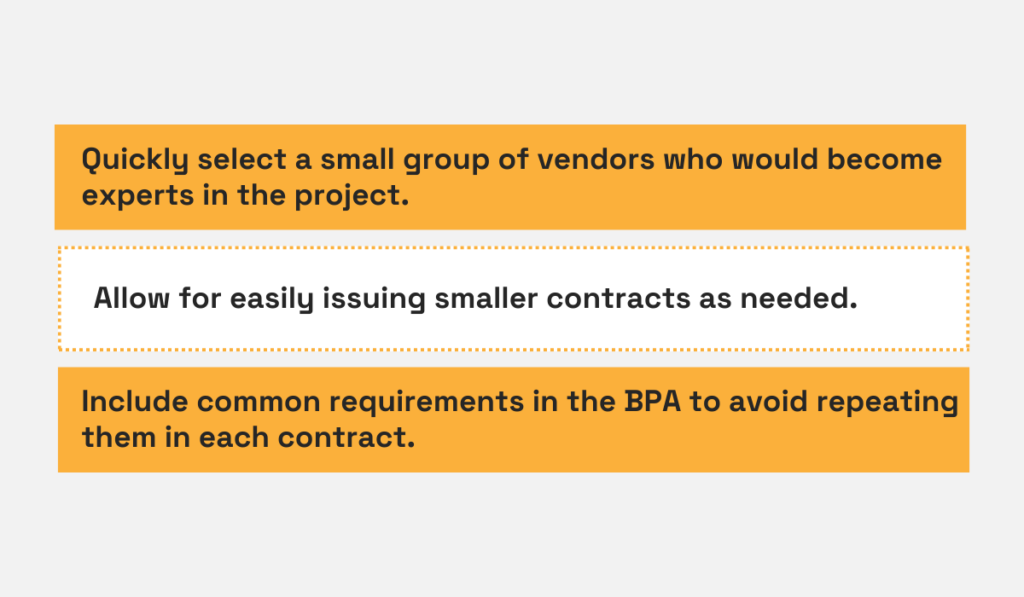
Illustration: Veridion / Data: Skylight
Creating the BPA involved figuring out what skills would be needed for the project.
Since CMS didn’t know all the requirements yet and knew they might change, they wrote a Performance Work Statement (PWS) outlining the needed skills.
This would help them write specific contracts later on.
To choose vendors for the BPA, CMS looked for ones with skills like agile software development, modern user research, and user-centered design.
They also considered past performance and had a selection process that narrowed down the vendors to the best ones.
To make sure the chosen vendors were ready to work, CMS gave them a design challenge matching the project’s needs.
This way, they could be confident the vendors could handle the work efficiently.
After setting up a contract to support their project, CMS focused on breaking the work into smaller parts.
This allowed for better management of the modernization process and quicker adaptation to changing needs.
Early outcomes included competitive bidding and the awarding of contracts within just 45 days, demonstrating the success of CMS’s shift to agile procurement.
In summary, CMS’s adoption of agile procurement principles enabled them to streamline the procurement process, mitigate risks, and adapt more efficiently to changing project requirements.
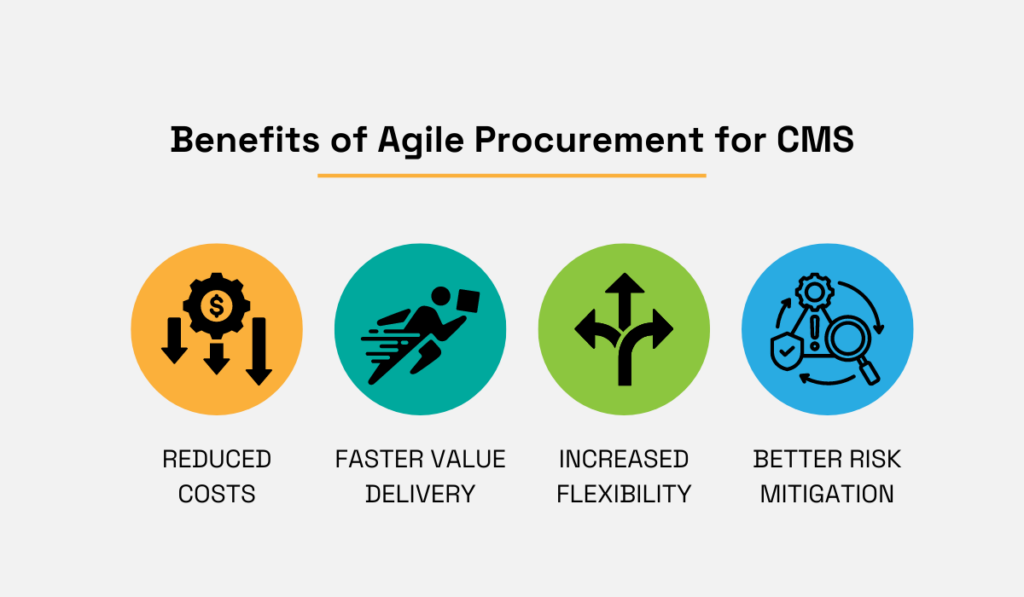
Source: Veridion
This approach allowed CMS to do two things: break the modernization process into smaller and more manageable tasks and deliver early value to stakeholders.
Both are core principles of agility.
Australia’s largest natural gas infrastructure business faced challenges with outdated tools for manually measuring gas consumption, handling over 12 million meter reads annually.
The introduction of smart meters in the Australian energy market prompted APA to rethink its approach.
Recognizing the need to evolve and meet changing customer needs, APA envisioned a digital future where customers could monitor their gas consumption directly by 2030, and where they would recognize the importance of the gas industry in energy consumption decisions.
However, APA’s traditional procurement methods, which focused on detailed specifications and minimal supplier consultation, didn’t align with this vision.
To address this, APA appointed lean agile coaches, formed cross-functional teams, and prioritized supplier’s cultural fit.
This shift led to less paperwork, a focus on immediate needs, and collaboration with suppliers to explore optimal solutions.
APA engaged selected suppliers in collaborative workshops, working in short bursts to refine product specifications and gather quick feedback.
Henriette Kamfer, Category Specialist at APA Group, acknowledges the challenges in transitioning to this agile approach, particularly in changing mindsets:
Source: Mirko Kleiner on YouTube
However, the benefits soon became evident as both buyers and stakeholders shifted their focus from product specifications to understanding the true needs of end customers.
They will use these tools, after all.
The results of APA’s agile procurement approach were profound, including:
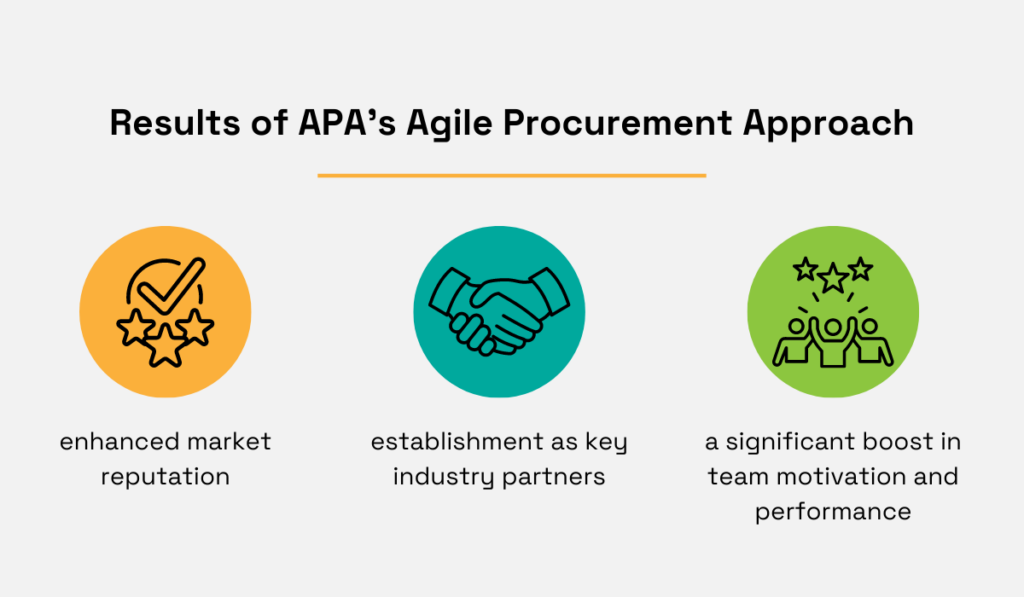
Illustration: Veridion / Data: Mirko Kleiner on YouTube
In the video above, Kamfer also highlighted the strategic role this kind of procurement has in driving innovation and ensuring business relevance.
By embracing agility, procurement teams can move beyond traditional sourcing processes, become catalysts for innovation, and even reshape perceptions and interactions with energy consumption in Australia.
In summary, APA Group’s adoption of agile procurement not only allowed them to adapt to market changes but also positioned them as leaders in driving innovation and customer-centricity in the energy sector.
AGCO Corporation, a leading American agricultural machinery manufacturer, operates in over 140 countries and has a diverse portfolio of well-known brands such as Massey Ferguson, Challenger, Fendt, and Valtra.
They are committed to innovation, sustainability, and providing solutions to help farmers improve productivity and efficiency in their operations.
To stay agile, AGCO has adopted innovative procurement practices.
They hold Agile Product Clinics, where both partners and competitors evaluate tractor components, sparking new ideas and finding alternative vendors.
Led by a team of experts from different departments, such as product management, engineering, production, and procurement, these clinics operate on agile principles of Scrum.
This ensures smooth teamwork and collaboration.
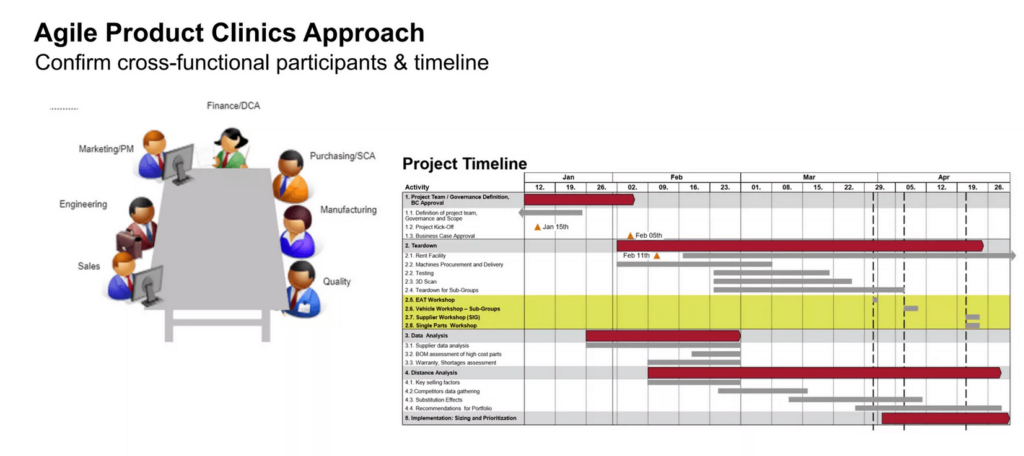
Source: LAP Alliance
AGCO has also digitized its sourcing operations since around 2012.
They use an e-sourcing platform to improve cost transparency and risk management.
This platform automates the capture of various cost factors, including material costs, overhead rates, labor costs, duties, inventory carrying costs, and packaging costs.
By providing a comprehensive view of these costs and facilitating apples-to-apples comparisons between suppliers, the platform empowers buyers to make informed decisions.
Moreover, this tool can analyze the cost of failure, enabling buyers to assess and mitigate risks associated with different suppliers and materials.
Another tool in their arsenal that makes them more agile and responsive is a risk notification and visualization solution.

Source: Sphera
This tool displays AGCO’s supply chain across multiple tiers and enables real-time monitoring and proactive risk mitigation.
This was especially useful during the COVID-19 pandemic, as it helped AGCO predict and mitigate disruptions, like anticipating factory shutdowns and speeding up shipments from affected regions.
For instance, AGCO predicted the shutdown of South Korean operations several days in advance and expedited shipments from impacted suppliers before plant closures.
Overall, AGCO’s adoption of these agile procurement practices and digital solutions has made their sourcing more efficient and their supply chain more resilient, enabling them to tackle challenges effectively.
In late 2018, Swiss Casinos Group decided to modernize its business model and embrace digital transformation by January 1, 2020, in response to market disruptions.
They faced the challenge of sourcing a new ERP system within a tight timeframe and recognized the limitations of traditional procurement methods in meeting their ambitious goals.
Traditional procurement, with its lengthy processes, RFPs, and focus on detailed specifications, proved inadequate for Swiss Casinos’ urgent needs.
To overcome these challenges, they, too, turned to Lean Agile Procurement.
With the help of Flowdays, an agile co-operative, Swiss Casinos formed a cross-functional team consisting of people from accounting, controlling, IT, and HR, and embraced Scrum methodology to drive the sourcing process.
This approach enabled quick decisions, ongoing feedback, and alignment with customer needs.
The highlight of their journey was a two-day workshop where shortlisted vendors worked closely with the Swiss Casinos team to create proposals and conduct proof-of-concept exercises.
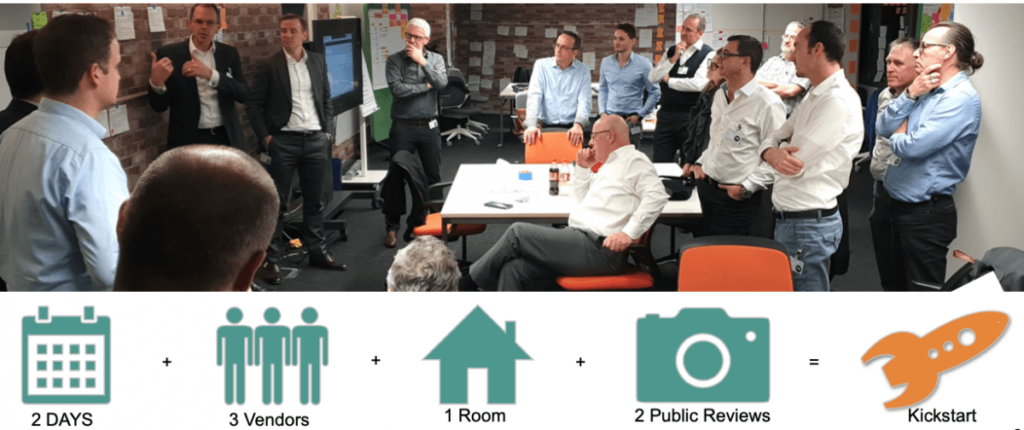
Source: Agile Business Consortium
This collaboration resulted in creating an agile contract within an impressively short timeframe, with negotiations completed in just 20 minutes per vendor.
Swiss Casinos achieved remarkable results with this agile procurement approach:
Stefan Meyer, Sponsor of the Shakira project and CFO of Swiss Casinos Services AG at that time, expressed confidence in the process, stating:
“It’s the first time I am convinced before even starting that we will create a good and valuable product for the users.”
This case study underscores the importance of agility and collaboration in procurement processes, especially in fast-paced industries such as casinos.
When Swiss Casinos decided to work through Lean Agile Procurement, they accelerated their digital transformation and set a new standard for efficiency in sourcing practices.
After all, they did source an ERP in just 4 weeks!
These were the six case studies that vividly illustrate the transformative impact of agile procurement in diverse industries.
From air cargo and healthcare to the gas industry, agriculture, and casinos, these organizations have leveraged agile principles to overcome challenges, drive innovation, and deliver value at unprecedented speed.
The key takeaway is clear: by embracing agility and collaboration in procurement processes, companies can adapt to change, mitigate risks, and stay ahead in today’s dynamic market landscape.
As Alejandro Basterrechea, Director of Indirect Procurement at Zalando, said, agile procurement is more than a methodology.
It’s a mindset.
As such, it is a strategic imperative for all those companies that seek to thrive in an ever-evolving business environment.